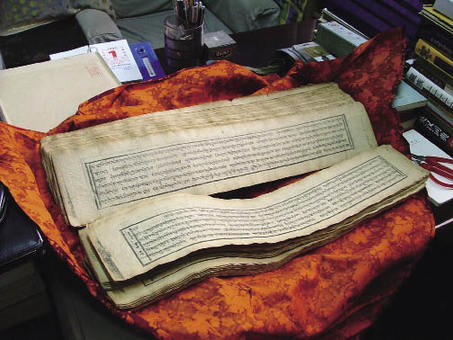| Traditional Tibetan Culture Transmitted
-- An Interview with Zhou Wei, director of the Institute for Socioeconomic Studies, China Tibetology Research Center
By staff reporter LI GUOWEN
ZHOU Wei, born in Qamdo in 1958, holds a doctorate in Tibetology, and writes and speaks Tibetan fluently. His tanned complexion stems from the annual field investigations of several months duration that he has made on the plateau. As the world witnesses the marked improvement in the local economy and people's livelihood in the autonomous region in the 60 years since its peaceful liberation, Zhou Wei points to how well traditional Tibetan culture is being transmitted in a modern society.
 |
|
An age-old Tripitaka of the narrow-page format exhibited by the China Tibetology Research Center. CNSphoto |
Tibetan Culture: Unique and Open
Tibetan culture, the subject of Dr. Zhou's research, covers a wide range of topics, but he splits it into two categories: tangible and intangible. The tangible culture refers to things recorded in historical documents, such as folk customs, costume and adornments, literature, Buddhism, sculpture, Thankas and architectural arts. The intangible culture covers mythology and legends, folk stories, ballads, prescriptions and the diagnostic/surgical techniques of Tibetan medicine that have not been passed down in written form.
He describes Tibetan culture as being very rich in connotations, spanning politics, economy, language, literature, religion and law. But the most characteristic and magnetizing element is, in his view, Tibetan Buddhism.
The history of Tibetan script started in the seventh century. Tibetan culture is a syncretic one, formed, like the culture of the Han Chinese, by multiple elements. Traditional Tibetan culture was influenced, from one direction by the culture of China's Central Plains area, and by the cultures of Nepal and India from the other direction. The stylistic influence of these two countries is apparent in Tibetan temple buildings, sculpture and religious rites. He characterizes Tibetan religious culture as having the indigenous Bon religion as the core, whilst absorbing elements from Nepal, India and the Chinese heartland.
Surrounded by multiple cultures, Tibetan culture shows an eclectic nature. Tibetan people have always been open-minded, ready to embrace the essence of other cultures. Men were dispatched in order to learn from other peoples, and eminent monks were invited to give lectures in Tibet. Through this absorption process, a unique Tibetan culture took shape.
This uniqueness, in Zhou's opinion, has been handed down intact to modern time.
|
